I’d promised to return to Northland after a couple of sensational visits, to Marsden Estate and then The Landing last year. This time, I’ve been asked to sit down and have a look at some of the smaller producers who have their wines produced by the team at Marsden Estate. I start off in the winery, surrounded by a whirr of activity amongst barrels and tanks. Rod sets off with his wine thief and brings back barrel samples, dodging the forklift and trying to remember what is where…
Rod MacIvor: We could start you off on a Sauvignon Blanc?
WineFolio: Sure – I just had a couple of ‘natural’ wines that were Sauvignon Blanc – it seems to be a varietal that suits the natural wine style? Done on skins, or cloudy, but with good fruit. And the barrel-fermented style is great too. I like this one – what is it? I love the citrus, mandarin flavours in that, and it’s got a much lower acidity. Has a hint of ginger spice at the back too.
RM: This is Larry Randall’s. But, Marlborough Sauvignon Blanc is a world class wine. And people want it to taste like that, in that flavour spectrum. I’ve got this Arneis from Dancing Petrel as well for you to try.
WF: It’s been a couple of years since I had an Arneis. If you hadn’t said, I might have guessed that it was an Albarino? It’s got that distinctive salinity, and a zesty fresh, crispness to it – like a Northern European white – like a Verdejo. I drink those and like them, in the right spot. I’m glad that varietals like this are still around. Like Viognier – there’s still quite a bit of interest in that.
RM: Viognier makes a great wine. I prefer a good Viognier to a Pinot Gris to be honest. The Yalumba one is nice for about $18.
WF: I know people who it’s their second favourite white wine. It’s nice, light and dry, with a really pithy textural finish to it. It’s not hugely characterful, but that’s a pretty good wine, particularly since you don’t see much of it.
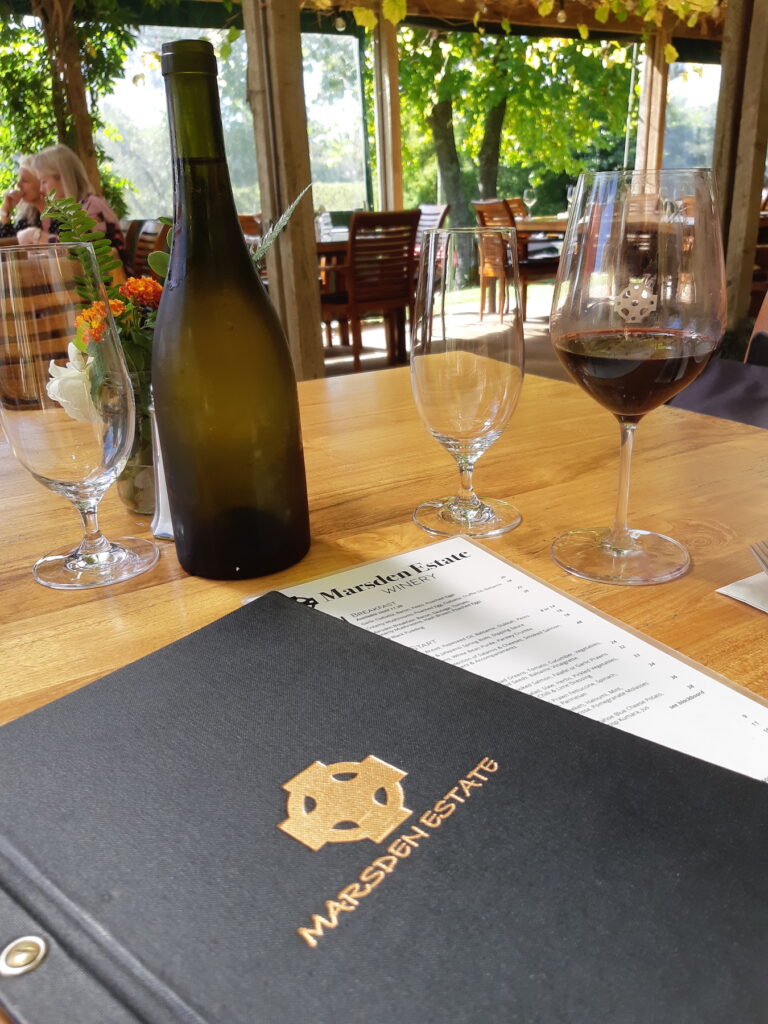
RM: This is from Kainui Road – you’ll see their vineyard as you head north. Not many people have tried a Northland Gewurztraminer.
WF: It’s not that I don’t like Gewurz, I just always find something else to drink. I like a glass of it. I’ll go for that style that is quite dry and without too much rose petal – with orange rind and a bit of oiliness. Or go absolutely full-blown, really rich and unctuous. If it has sweetness it’s got to fit in, and I find sometimes with Gewurz it doesn’t, it just sits on top of everything, drowning out the other parts. There’s something about this – the yeastiness I suppose, that reminds me of Champagne!
RM: That’s funny because we have turned it into sparkling for them in the past. They have concerts at the property and they had it for the event. The only other one we’ve had was from Millars down in Mangawhai and we gave it quite a bit of skin contact and it was delicious. That was in 2015, I don’t know if they still do it. As you say, it’s not a wine that’s going to fly off the shelves.
WF: It will do well on the right wine list if the sommelier knows what they’re doing, and always a winner at a Cellar Door – like Gruner Veltliner or Viognier, where people buy it because it’s different. “Look I got this and I can’t even pronounce the name!”
RM: That’s the beauty of a Cellar Door – you get people to drink stuff they wouldn’t normally drink. Because you’re getting them to taste it, and it’s something different. They’re taking away that story. It’s a privilege to be able to play with so many different wines. That’s why these young guys are here – they could be off making lots of money, but they love the wine. It’s a great thing to be involved in. We’re at the pleasure end of the spectrum.
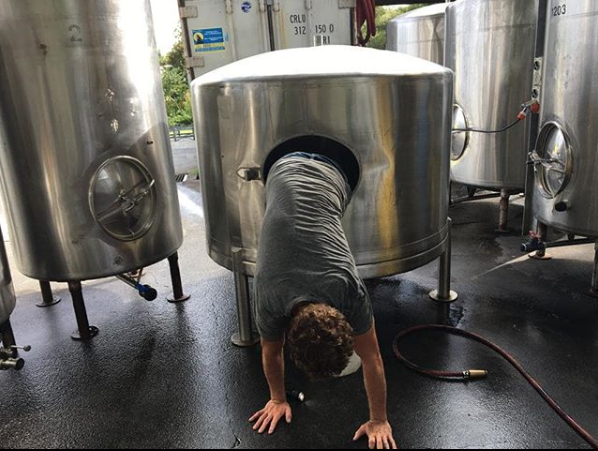
My major enjoyment in the process would be growing the fruit. I love the work you do in the vineyard. That’s the challenge – getting a good product, because if you haven’t got that, then it doesn’t matter what you do at the other end. And the one thing about that which is probably the most humbling is that you haven’t got full control. This year we had two days of heavy rain, but it was late enough that we’d picked the whites, and early enough that it didn’t totally f*ck up the reds.
This is Viognier – barrel fermented, from a four year old barrel. They’ve got a stainless steel portion as well. The wine from 2020 that you tried was a pretty nice wine. Sometimes the acid can drop out if they get too ripe, but this year, with the growing season and we’re so early, the acid is still there.
WF: that’s a decent wine again – I like the honeycomb edge to the back of the palate, after all the apple and pear and citrus flavours; it’s a nice contrast. You can see the barrel influence but it’s hiding, and I guess that will edge down again once the tank portion gets blended in.
RM: And this is the Marsden Chardonnay from this year – in a two year old barrel. Just stirred yesterday and about dry, starting to get it to go through malo.
WF: It’s a wee bit edgy just yet. Do you just make the one Chardonnay?
RM: Yes, we don’t have enough to do more. We could double production of the one and we’d still sell it. Problem is we have to release it too early. We’ve had the ‘20s out since February – we ran out of ’19. It’s too young, but we’ve sold two pallets of it. It’s an unfortunate fact of life.
Try this Pinotage – it has a milky colour to it – our ones do. I think because we try to make a lighter style of it. I don’t find it appealing when it’s young, and it’s not dry yet obviously. You’ll see how that evolves when you try the ’20.
WF: I’ve spent a bit of time over the years, looking at aromas of things, so I do tend to have both quite a focus on that when I’m looking at wine, but also, a library of things that I’ve tried – well, smelt obviously.
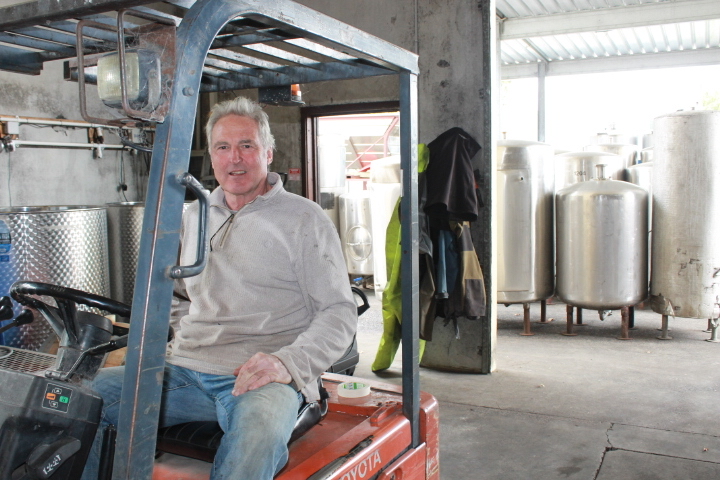
For example, there’s this thing called ‘orris root’ and it’s used in making perfumes and used to be put into pot pourri. It has a specific smell, with florals like old-fashioned violet or rose floral, then mint and raspberry. And that’s what I’m getting in this Pinotage. Clearly if I said ‘orris root’ you probably wouldn’t know what I meant! (laughs).
RM: Finally – this is Chambo. A lot of the smaller growers plant it because it takes care of itself. You don’t have to leaf pluck it, or do much at all.
WF: Makes a decent wine too. Robust and spicy.
RM: Yeah it does. And it’s the one variety that Brett loves, it just gets straight into it.
WF: But that’s in its character, and the French will tell you all about terroir and character, and letting that show in the wines. It’s earthy and barnyard-y, and I don’t mind that, a little bit.
RM: Yes, a little bit. The other thing about Chambo, it’s normally a fairly neutral flavour. It fits in between other reds. At the other end is this – try that..
WF: Ok, that’s ripe but pretty solid. Nice acidity but the tannins are quite chewy at the moment. Can’t pick what grape that could be – unless it’s some of that elusive Tannat that I know you’ve got up here, and I’m determined to track down?!
RM: Wow, yes, it is Tannat! It’s Dancing Petrel 2020.
WF: Awesome. There’s quite a bit in that. I like the acidity as well as the depth and concentration. Cranberries and plums. Bit of red liquorice.
RM: It’s a great blending component as well. They grow it a lot in Argentina and Uruguay. We could spend a week looking at everything, but that’s a snapshot of this years.
WF: What’s the smallest thing you do?
RM: See those two 20 litre drums? We’ve got a Lawyer, coming to pick his wine up today – and it’s bloody good! We bottled it for him yesterday.
We move through to a table in the corner of the Cellar Door, and start to look at a selection of bottles – some of which have been sent over for this tasting, some just from the cellars at Marsden Estate.
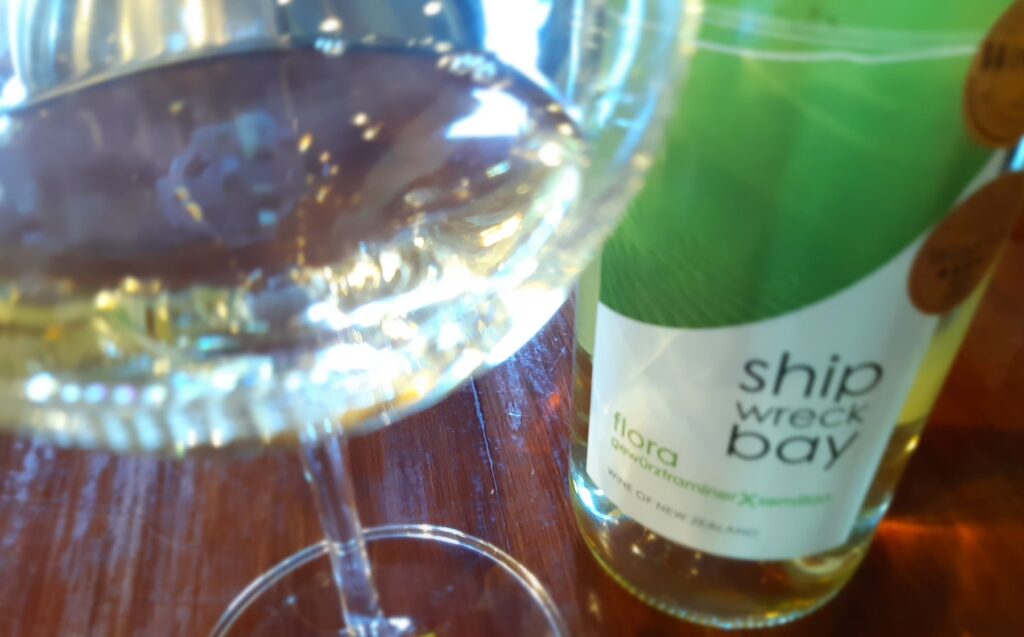
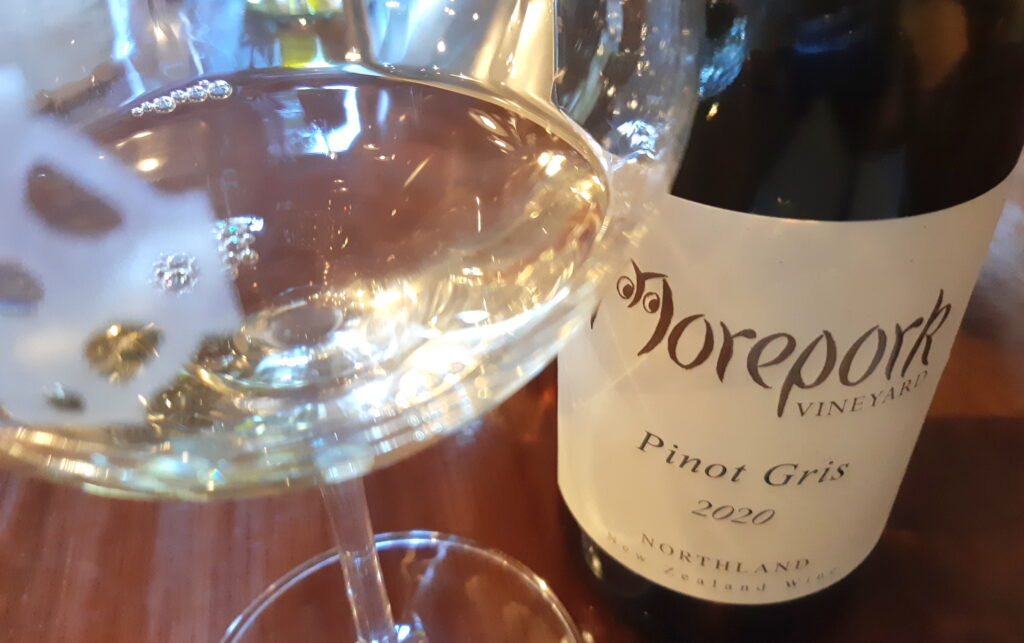
RM: This is a 2020 Flora, the label is ‘Shipwreck Bay’. He was in last weekend and dropped this off and said ‘just try it’ so…since it’s here, let me know what you think?
Rod brings in a couple of his winemaking staff Justin and Pietro, to join in the tasting..
Justin: Are you on the Flora there?
WF: Yes, I’m hogging it all. I don’t hate it. It says on the bottle Gewurztarminer/Semiilon – is that what Flora is?
RM: Yes, and it’s better than I remember it, it’s developed quite well. It’s one of those that’s bulletproof. You can crop the hell out of it and it grows anywhere. It can go from just about being ready to be picked, to being over-ripe in about four days.
WF: That would be a great food wine. I like those ‘thai beef salads’ with a little kick to them, and that would be OK with one of those.
RM: Obviously he’s reasonably happy with it, otherwise he wouldn’t have given it to us to try. We’ve got three Pinot Gris – and we usually don’t try these after they’ve been bottled.. Possibly three more than we need!
WF: No, not at all. Being someone that can go through trying fifty Sauvignon Blancs in a morning… I also attempt to be Mr Pinot Gris as well. I like breadth of the styles of it. I obviously don’t like the ones that are utterly bland and innocuous, but I do rate some of the ones that I think are taken seriously, and I love the good, old ones. I had a Rockburn one from 2002 that was sensational recently, in the last year.
J: They can cellar really well. I remember when I first started here, you’d give me a heap of really old ones that you were getting rid of. And one of them was a 2004 Pinot Gris and that was amazing. Something like Dry River – their Pinot Gris is renowned for cellaring well.
Pietro: What was it about that old Pinot Gris that you liked?
WF: It still had some fruit showing, so I think it must have had plenty of acidity when it was put in the bottle. I think it had been in that off-dry style, so that had fattened out well and gone waxy and unctuous. Lots of honeycomb and baking spice at the end. We had it as an aperitif and I though that worked really well. I drank beautifully – just a lovely older bottle of white wine with good development. Under cork as well.
Then – the highlight of the day – Rod reappears with a bottle labelled ‘2004 Pinot Gris’ – opens it, and pours out…olive oil!!
RM: Hell. I’ve got two more of these up there. I must have given away all the old corked Pinot Gris. Would you like to try an aged olive oil? (laughs). Or, I’ve got another Pinot Gris – hopefully it is! This is Morepork 2020. They do a great job growing it – it’s an older clone.
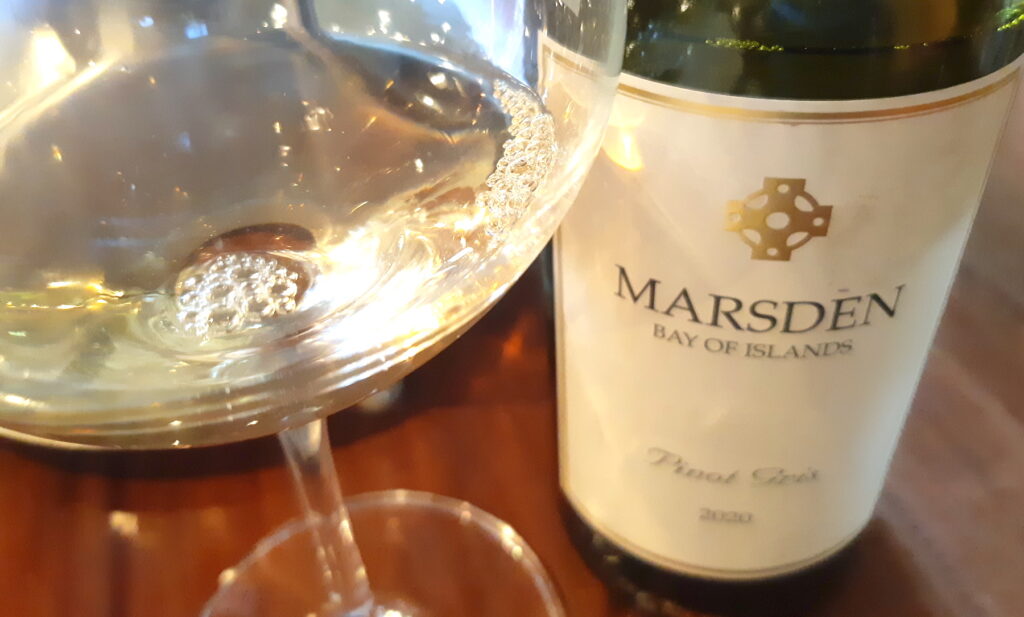
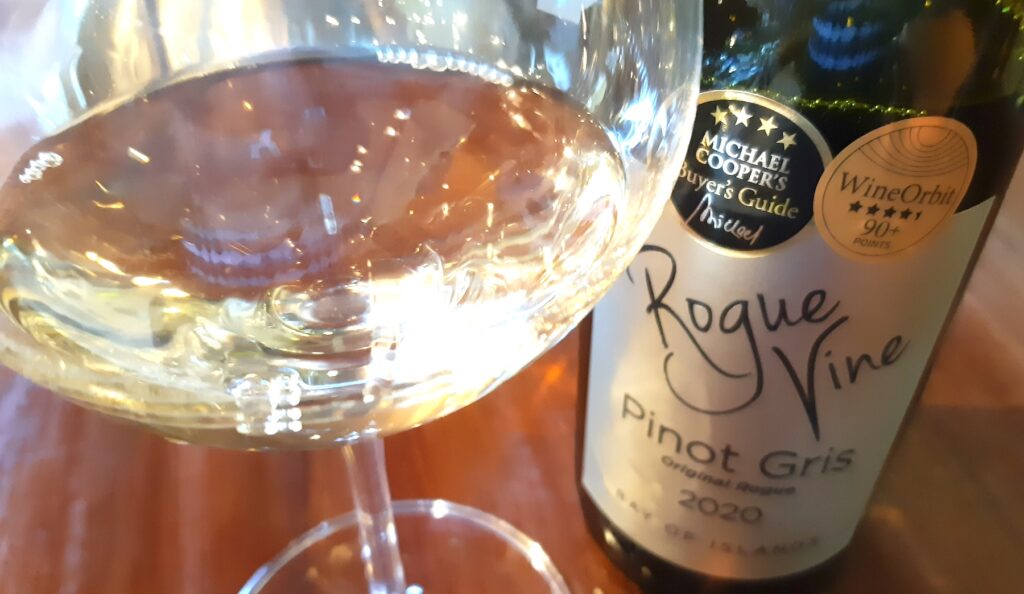
P: This has a stalky, savoury note to it – less fruity.
WF: Phenolic, with a roast carrot savouriness to it. It’s still got a bit of pear, nutmeg varietal character, but I can’t say I’m crazy about that one. I’m not sure what I think of it right now, but I wonder if it might age quite well? Like we were just talking about?
P: It might be a hard sell though, to change people’s perceptions on keeping Pinot Gris to age.
WF: Well you say that, and my interview with Gordon Russell, where we talked at length about the ageability of his Esk Valley ones, was over a year ago now. Now I just saw recently another wine writer who does a lot more social media than I do – banging on about an older Pinot Gris they’d been sent, and waxing lyrical about it. I can’t claim to have invented the idea obviously, but, yeah… you know. Look for a really good producer, and not a 4-5 year old one – go for a ten year old version.
J: I think New Zealand wine drinkers buy their wines and drink them straightaway. I don’t think they have the patience to cellar them for that long.
WF: Probably they just wouldn’t think to. It’s like getting a good Sauvignon Blanc and putting that away for a decade? People just don’t think of it. They don’t think – older equals better, so they don’t do it. I do. In fact if I go places and I think they may have older stock, I ask them. When I was at Lime Rock they had some for sale, just on the side – like 2005’s, so I was like ‘give me those’. I have to be quite careful with buying wine as it has to be quite targeted. Often I’m having wine because I have to review it, not necessarily because I chose it. So when I drink what I really want to, it’s not as often as you might think.
I look at a bottle of Marsden Estate Pinot Gris, that’s up next…
When a bottle of wine is labelled Mardsen Estate – is that fruit from a vineyard that you own, or just something you buy in?
RM: It’s our fruit from our vineyard. Other than the Sauvignon that comes from Marlborough, all the other wines are from here. We got the new clones of Pinot Gris because they’re not as tight-bunched but they seem to have that lemony than apple and pear. The old clone if you got it under-ripe was like Granny Smith and if you got it ripe it was more towards the pear. The fruit is much better to grow though.
WF: I’m getting a little eucalyptus character at the back of that one. I don’t mind that, and I can see that it’s got that citrus rather than apple and pear, but, again, that’s OK. The palate has a nice balance.
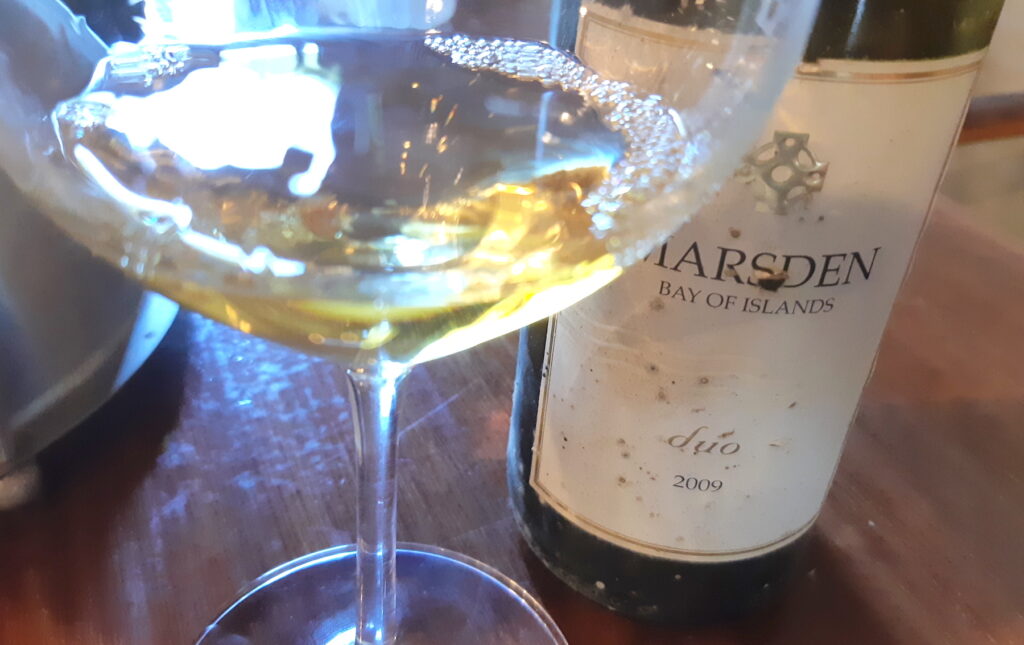
Rod runs off to deal with the customer he mentioned earlier, so we open a Marsden Estate ‘Duo’ from 2009 while he’s not looking…
WF: Oh wow…OK!
P: It kind of tastes like one of those old Landing Chardonnays
WF: So what is it? I’m thinking it’s Flora again..
J: I think it is, and he called it Duo because it’s a varietal cross of Gewurz and Semillon – so, Duo?
WF: ‘Cellar for two to three years… bone dry, food friendly wine’ it says here on the label. Yum. That’s pretty ripe, and it’s got a bit of oak in there, a bit toasty. That’s actually quite intense and concentrated. It’s straw coloured in the glass, but its almost got a flavour of meadow grass, hay and straw as well. And I love that it is really dry. I’ve only ever had Flora as a young, fresh wine, but this is quite something, with all this age.
RM: It’s certainly got some bottle age character. It won’t last long once it’s been opened. We’ll try this 2020 Chardonnay – personally I’d give this another six months, then I’d be really happy. You notice that little bit more acid with it not being cold stabilised. It was beautiful fruit, couldn’t ask for better.
WF: I think that looks pretty good now. When I had the early releases of the 2019s I was quite disappointed.
RM: I think you know pretty well when you get your fruit in if the wine is going to be Ok. You’ve got to be brave enough to let it. But I wish we didn’t have to release that yet. It’s not our decision, if the public want to take it home and cellar it. By the time it’s get to anywhere near it’s best it will all be sold out.
WF: So why not make that decision for them and just not release it?
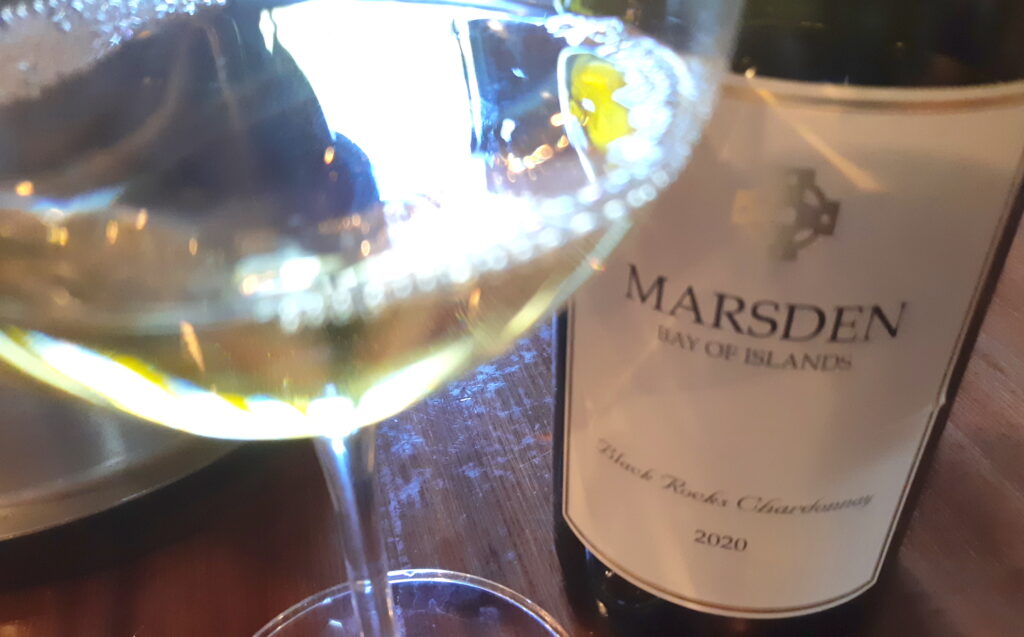
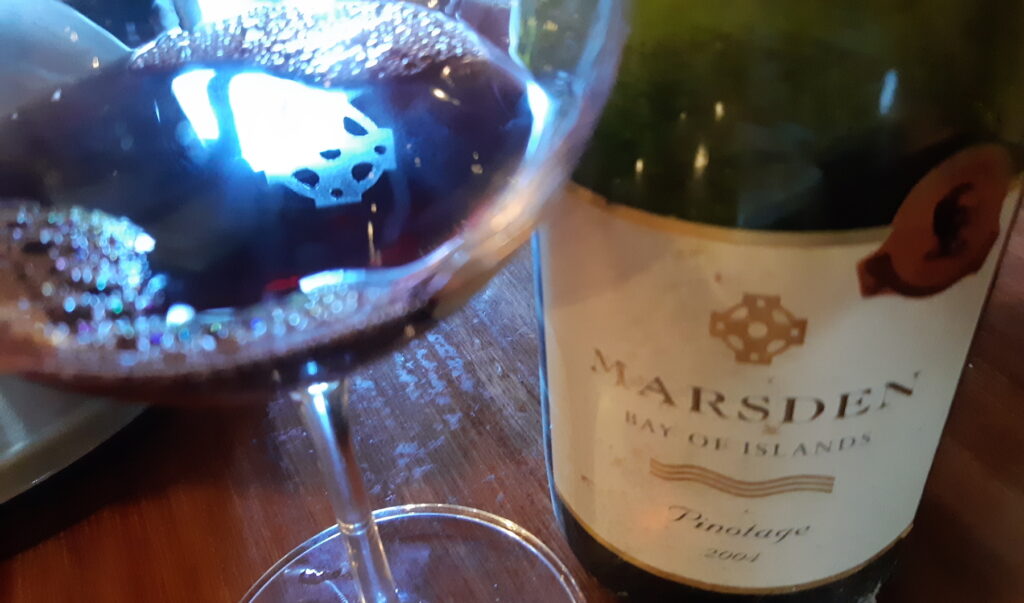
RM: Well then I won’t have a Chardonnay to sell. I’d rather give the person on the other side of the counter the decision. Say “Look it’s not really ready to drink now but you’re welcome to buy it”. They should cellar it, but most Kiwis don’t. We had a guy in from Hawke’s Bay yesterday, and he bought a case. A case at $42 a bottle is good money. We’ve had absolutely no negative comments about that wine since we released it.
We might try that 2020 Pinotage – it hasn’t been bottled all that long. I did find an old one, I missed the Pinot Gris but I found a Pinotage.
P: What do think about Natural wines?
WF: Yes, definitely something of interest. I’m quite new to it, but I was fortunate in that a place I went and stayed is very focussed on natural wines. I like the wines that I’ve had that are really good wines anyway, just that they are made in a natural wine way? There are a couple of big producers – Carrick or Ata Rangi for example, and those are effectively natural wines. It still tastes like really good wine. Doesn’t have to be cloudy and oxidised to be natural wine. I like that it makes you think about wine, at all.
RM: We’ve got 250 Pinotage vines, but we crop the hell out of it (laughs). We probably did five or six barrels. You tried the Pinotage before, so that’s how it comes out. I’m really happy with that. It’s a variety that’s disappearing.
WF: I like that it’s not too heavy. It’s quite agile and light on it’s feet. The tannin and the oak is nicely balanced. It’s got a mocha note to it, and it’s so smooth! I’ve had some over-extracted teeth-staining monster Pinotages in my time.
RM: It fits in well with us because it’s a lighter style. I couldn’t find a Pinot Gris, but there’s a 2004 Pinotage. The cork looks like new! The 04, 05 and 06 vintages were excellent. 2006 was the better one. I recall Michael Cooper saying he didn’t think Pinotages would age that well, but we had some good years and they were great and keep for quite a long time.
WF: The nose is starting to fade, but the palate is so fresh!
RM: I had an email from some guy the other day about a 2010 Chambo he’d bought off me, and he wanted to tell me that it was absolutely magnificent! And I wouldn’t have thought that Chambo would have much of a life either..this has quite similar characteristics.
WF: The only real bit of age that’s showing is on the nose. It’s got a kind of root beer turn to it, on the nose. It almost seemed a little corky when I first got into it, but it’s not stale, it just needed a bit of time to breathe. It’s still really fresh to taste, and a lovely savoury line through that, like a mature Pinot. That’s Wine of the Day that.
RM: Shall we try that Mahinepua Merlot 2019? They’re right on the coast and get really good fruit.
WF: It’s got a darkness to that – not just all soft juicy plums. Again, quite a savoury line with tobacco leaf and leather. Broodingly dark and ripe. Got a Merlot nose, but then it gets all kind of Malbec through the middle. Outstanding tannins in that – ripe and dense. It’s got a roundness that says ‘blend’ to me if I’d had to guess – Merlot-Malbec-Cabernet Franc. Got that mossy, bark and earth to it.
RM: We’ll do a couple more Chambo’s? First off is ours – a 2019 Marsden Chambourcin, then a Mahinepua Chambourcin 2016.
WF: Do you do much whole bunch here? That’s got a slightly stalky, green but spicy character that smacks of that?
RM: Yes, we do, but I can’t remember about ’19. I can only remember the last two vintages! It’s not as rich as the ’20 or ’21. I’m not overly impressed with that to be honest.
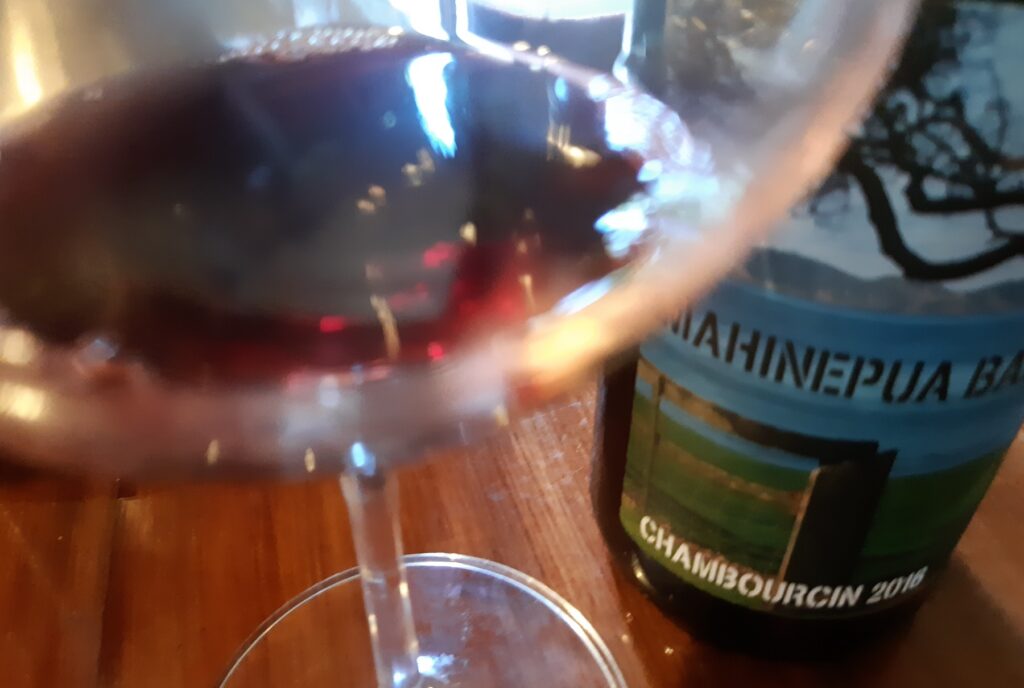
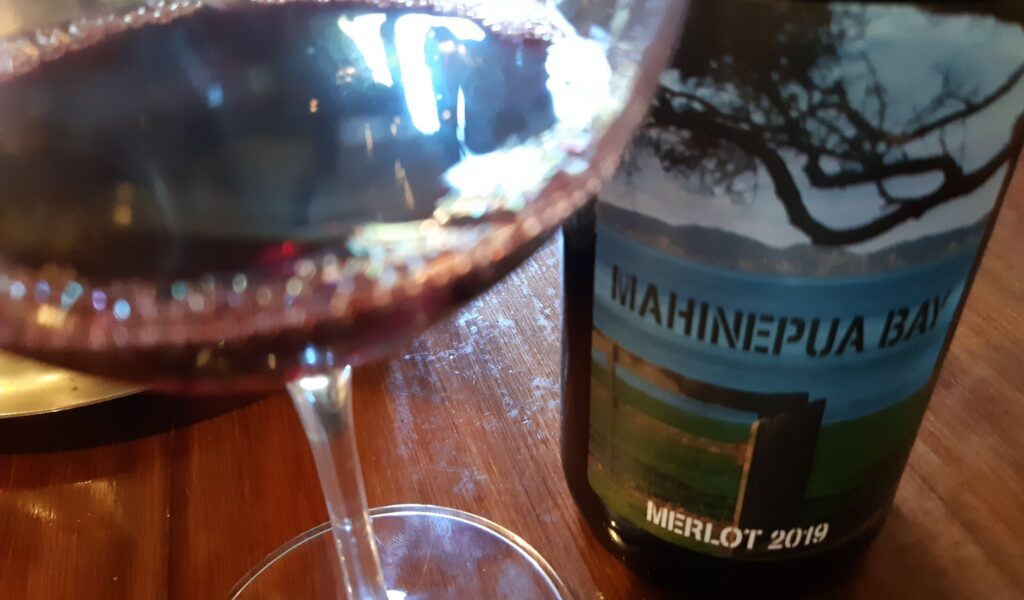
J: in 2020 we did quite a bit of whole bunch and did that whole berry thing as a component. It’s not Brett-y.
WF: That one is quite vibrant. I find that some of those reds from the cooler years can really shine after a few years. Like Central Otago Pinots from cooler years for example. Some nice, sweet oak and the tannins are smooth but quite lively.
RM: I don’t think I’ve tried this – a Marsden Estate Tempranillo 2019. How’s that tasting?
WF: Absolutely fantastic. Is that from here? Far out, that’s good. So, a ’19 Tempranillo I would expect it to be quite tight and a bit chewy maybe.
RM: The tannins are always just silky on the Temp. I think I said that in 2010 we got 20 litres of it, and I was so impressed with it I went and planted another 400 vines. We did it in one of those plastic drums and it was drinkable straight after ferment. But it is temperamental. If it gets any rain it splits. We turned all of ours into rosé this year. Out of ten years we probably make it six years. The other years we turn it into rose but when you get it right… There’s one of Stuart Fraser’s – he’s on the coast. But we can get it ripe. It’s stunning but we’re talking 27 brix! At Dancing Petrel they’re looking at different varieties to plant. Tempranillo would go well up there.
J: It’s pretty popular at the Cellar Door. Maybe because it’s different from the Tempranillo they’ve bought from the supermarket on the cheap.
RM: Michael Cooper’s just done a review of it somewhere because they rang up and said ‘he’s just rated your Tempranillo and it’s going to go into the article – would you like to get a bottle shot for $400?’. I said ‘No’ (laughs). It’s like Dish Magazine you know? Your Chardonnay gets in the top 1000 of them and it costs you $500 for a bottle shot. And really those things don’t translate to anything else, other than having it in a magazine, which is always nice but that’s about as far as it goes. Our best way of advertising and promoting is to get people to try the wines at the Cellar Door.
WF: The Syrah Top 10 Tasting that I did at the end of March. That had the biggest day of traffic to the website. The first day after the results came out; and then the second day would have been the biggest day of traffic if it hadn’t been for the first day. So both days were record traffic. Someone actually commented that they thought it was “a landmark tasting of NZ Syrah”. I think because the calibre of wines that were there were excellent. I can say that you could look at wines that didn’t make the Top 10 list – right down to 28th place and you’d say “I would buy that wine”.
RM: Does that show you the standard of New Zealand Syrahs?
WF: Well I think so, yes. I had a few people who read the article and emailed me saying “can I come to the next one?” and I have to say ‘well it’s not a public event..’
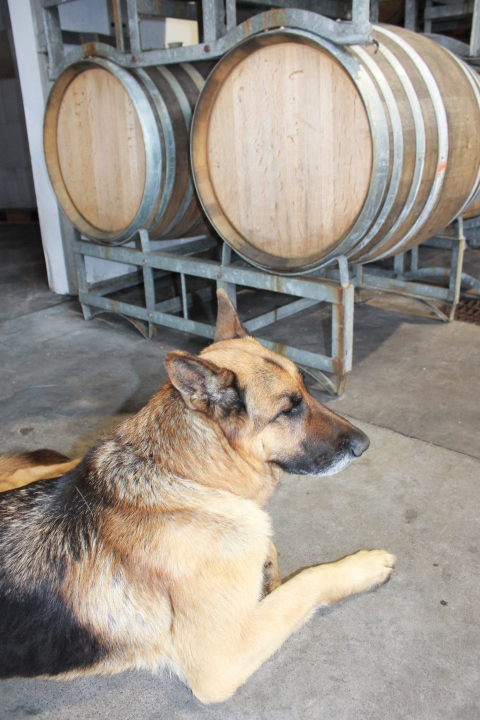
So there’s definitely interest in the best of New Zealand wine, and therefore in what I’m doing. Because that’s what I’m looking at. And one of the reasons I call my sessions the “Top 10 tasting” is that people love Top 10 Lists of things. It goes really well. Again. I’ve had people contact me and say “Right, I bought all of those wines on the Top 10 – when’s the next one?” Which is great.
RM: There’s not a huge amount of writing done about wine now. There used to be something about wine all the time, but now.. where do you read about wine? It’s not in the Herald?
WF: Well, I actually wrote to “Stuff” which is that alternative news site to the NZ Herald. They have a section called ‘Food & Wine’ and I counted how many articles were on that page… nineteen articles about food and ONE article about wine. And do you know what the wine article was about? Which wine glasses you should use!! So it wasn’t even about wine, it was about glassware. I just emailed them and said “Are you kidding me? As someone who is interested in wine – your wine coverage is a joke”. No reply. I despair, because the coverage of wine going back even just five to ten years ago used to be fantastic, it used to be serious.
RM: This is Monty’s Syrah. The only reason we’re having it is because he dropped a sample off and it’s sat here for quite some time. It’s called Shipwreck Bay 2015 Syrah. We put in 1% Flora into it.
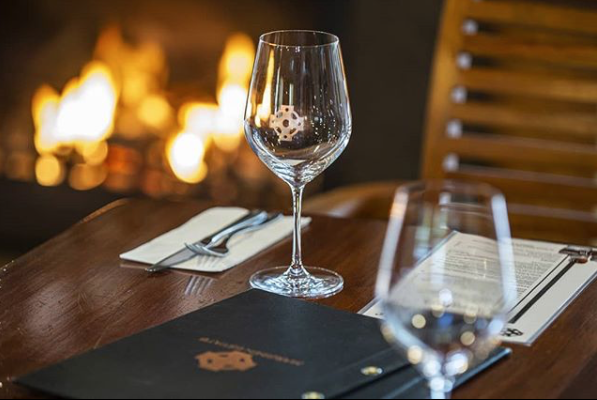
WF: Is that like when people put some Viognier into their Syrah? What’s the purpose of that?
RM: When you do that, it’s normally skins and you do it at ferment. It does two things. It gives it a slightly floral complexity and it’s supposed to intensify the colour. I mean you’ve got to have Viognier to do it, so most people who’ve got a supply of Viognier have the ability to do it. I think when it’s overdone it’s too much.
One of them, the Bullnose I think, has it, and to me it’s too much. The reason that Monty did the Flora was that they wanted to freshen up the Syrah.
WF: It’s definitely at that lighter end, with a raspberry taste, rather than a deep liquorice like you get in Hawke’s Bay sometimes. It’s got a musky sort of flavour to it – roasted spices and dried rose petals. If that’s a cheap Syrah – $20 wine, then it’s OK.
RM: Now, the Mahinepua Syrah 2019 – Roger wasn’t going to put this in because he said it hasn’t settled down. He hasn’t released it yet and he’s not happy with it. I said ‘chuck it in and we’ll have a look at it anyway’.
WF: It’s a bit dominated by those tannins. It’s quite disjointed though – it’s like this is here, that’s over there…and it’s not giving much away on the nose – which I’d argue is essential for a Syrah?
RM: Sounds like you won’t make it over to Omata this trip, so we should do one last Syrah. It’s been here for a couple of weeks.
WF: So this is the 2019 Omata Syrah? You’ve been talking this one up, let’s be at it.
RM: Site selection is so important – what nature gives you! This is on clay and that’s the intensity you get. Good tannins but you wait five years. This retails for around $50.
WF: You put that in Hawke’s Bay it would be a serious, single vineyard, high priced wine. You might not see that for another year as well.
RM: It has that meaty, fleshy character – that site always has it.
WF: Great length. And I love that despite the floral nose and the real purity of the fruit… that it has that tar – a kind of dirt to it too. A good dirt. And weight.
J: It’s shame they don’t put it in more tastings and competitions.
WF: I should have found time to go last time, but as you know we were staying in the Duke, and the wife was keen to get down there and get unpacked. But I said we should fit in another winery beforehand, and when we went up to Paroa Bay she was actually pretty happy up there. Had some cheese and wines. And the wines were pretty good.
RM: They’ve got a new winemaker up there so hopefully they will get some support and do a good job. The vines are struggling but if they can get the support, they can get the fruit ripe. If I could have a site like that, I’d kill for it.

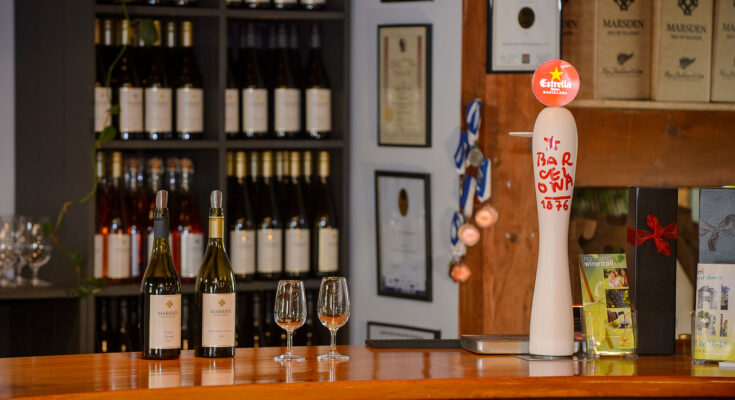
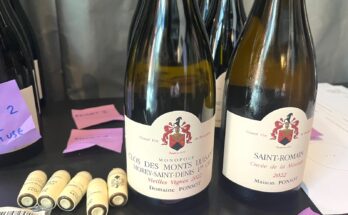

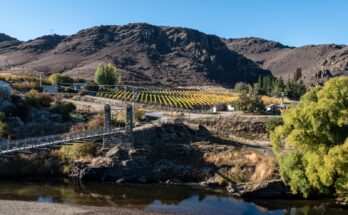
So many wines I’ve not heard of before – I am saving this to take away with me next month in Northland!